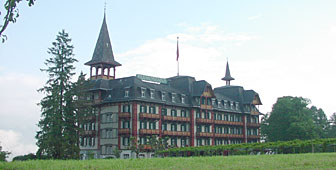Grand hotels provide a flavour of the Belle Epoque

The age of opulence can still be experienced at two of Switzerland's finest Belle Epoque hotels, as Vanessa Mock discovered.
The Grand Hotel Giessbach and the Paxmontana provide a glimpse of what life was like for the wealthy in Europe before the First World War.
Walking into the Giessbach is literally like taking a step back into an age of grandeur and sophistication.
Everywhere you turn there’s another ballroom or banqueting room festooned with chandeliers and magnificent oil paintings and it’s easy to see why guests such as the Russian imperial family and British royals came here before 1914.
“We want our guests to feel they are stepping back in time and we want them to savour the atmosphere, which is very special here,” says the hotel’s manager, Fritz Kreis, who is the epitome of old-world charm.
Relaxed ambience
Yet despite the magnificent décor and architecture dating from the 1870s and 1880s, the hotel manages to avoid feeling stuffy or overwhelming.
The antique-laden rooms, too, are exquisite, particularly those facing the breathtaking expanse of Lake Brienz or the Giessbach Falls, the sound of which echoes through the building.
The hotel also holds numerous classical music concerts and balls, which Kreis says are attended by an increasingly young clientele.
“Our guests used to be elderly, but in the past few years we’ve really noticed that younger people are coming here and they seem to really appreciate the timelessness of the hotel,” Kreis says.
Visitors departing from the hotel can prolong the experience by hopping on to the Lötschberg steamboat, which departs directly from Giessbach, for a trip across Lake Brienz.
Getting to the boat necessitates a trip on Europe’s oldest funicular, built especially to serve the guests of the Grand Hotel Giessbach in 1879.
The ferry itself has been completely restored to its original steaming glory, and comes complete with a restaurant and staff in dapper uniforms.
Paxmontana
A stunning train journey away in the mountain village of Flueli Ranft, canton Obwalden, lies a similar Belle Epoque gem, the Paxmontana.
As I approached the hotel, a large cream and rust coloured building built in 1896, mist hung around the mountain peaks and covered Lake Sarnen in the valley below. Inside, the hotel is all warm lighting, gleaming wooden floors and ornate cornices, immaculately restored in keeping with the original Art Nouveau décor.
“I like to think about my hotel as big old ship in an ocean of mountains and valleys,” said the hotel’s affable director, Martin Küttel. “We want our guests to savour the spectacular surroundings and to rid themselves of things like emails and mobiles. There’s no place for that here. This is a place for peacefulness and relaxation.”
Art Nouveau
It’s certainly easy to relax in the hotel’s beautiful dining room and savour the excellent cuisine and the unparalleled views. Among the many renovated rooms is a lovely library with a stunning Art Nouveau ceiling of gold and green.
“We always put our profits back into renovation – this winter alone, we ploughed SFr450,000 into restoration work,” Küttel explains. “The building has to kept good shape to survive in future.”
One major shortcoming of the Paxmontana is the austerity of the bedrooms, many of which have not yet been restored. My room had a distinctly austere feel, with a wooden cross hanging above the bed.
In keeping with the feel of a retreat, televisions or radios are available only on request. “There’s no demand for them,” Küttel assured me.
However, I was left wondering what guests found to do after a day in the great outdoors, as the Paxmontana does not offer any evening entertainment – there is not even a bar.
The cross and the lack of merry-making may have something to do with the hotel’s past. Originally frequented by wealthy English tourists, it spent part of the 20th-century history as a far less opulent resting place for modern pilgrims, hence the crosses in the bedrooms.
They were paying homage to Brother Klaus, a 15th-century monk canonised by the Catholic church, who lived in the nearby village of Sachseln.
by Vanessa Mock

In compliance with the JTI standards
More: SWI swissinfo.ch certified by the Journalism Trust Initiative
You can find an overview of ongoing debates with our journalists here. Please join us!
If you want to start a conversation about a topic raised in this article or want to report factual errors, email us at english@swissinfo.ch.